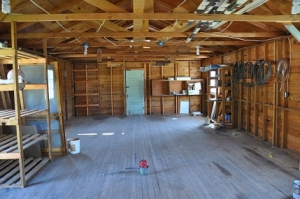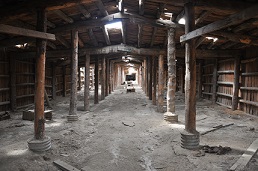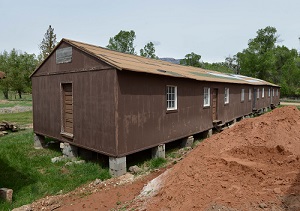
Heart Mountain WW II Interpretive Center Celebrates Return of Original Barrack; Preps for All Camps Pilgrimage
CODY, Wyo., August 5, 2015 – August is a pivotal month for the Heart Mountain WW II Interpretive Center, a WW II Japanese-American confinement site where some 14,000 incarcerees – more than the population of nearby Cody, Wyo. at the time – were housed during the war. A National Historic Landmark, Heart Mountain will hold its annual pilgrimage August 21 – 22. Headlining the event will be the celebration of the return of an original barrack and dedication of the root cellar.
Although it was closed 70 years ago, the site has long served as a powerful reminder of the time when Japanese-Americans were forced to leave their homes and relocate to a windswept, barren region outside of Cody. Incarcerees occupied the massive camp from August 1942 through November 1945.
Returning a piece of history

Multiple families lived in spartan conditions in the camp.
The 20-foot by 120-foot barrack is located in Shell, Wyo., approximately 80 miles from Cody, where it was used as a research facility by Iowa State University for more than 50 years. The university determined that it no longer needed the barrack, and it was gearing up to destroy the building to clear the way for new housing. When the Heart Mountain Wyoming Foundation (HMWF) learned of the university’s plans, however, it negotiated with the university to donate the building if HMWF would move it to the Heart Mountain site.
HMWF began a major fundraising effort to raise the $140,000 necessary to move the building, construct a permanent home and preserve the structure for public view. The fundraising effort gained significant momentum with a $10,000 donation from the Wyoming Cultural Trust Fund, and nearly $32,000 has now been raised to meet this goal. For a $25 contribution, for example, donors can receive a commemorative case with an original square nail used to build barracks.

The root cellar stored produce grown and harvested at Heart Mountain.
All Camps Pilgrimage
In other Heart Mountain news this month, the Heart Mountain Wyoming Foundation is gearing up for its annual pilgrimage, this year scheduled for Aug. 21-22. This year’s theme is “All Camps,” and events showcase the experiences and stories of former incarcerees from Heart Mountain as well as other Japanese-American confinement sites from around the country.
Guest speakers will include George Masao Yamazawa Jr., known simply as “G,” a Durham, N.C. artist raised by Japanese immigrants, and one of the youngest poets to become a National Poetry Slam champion. Other speakers include former senator Al Simpson and former U.S. Secretary of Transportation Norman Mineta. The two met and became lifelong friends when Cody resident Simpson and incarceree Mineta met as boy scouts.
Root Cellar
Also during the pilgrimage, Heart Mountain will dedicate the only remaining root cellar. Root cellars played a key part in preserving the produce planted and harvested by the incarcerees. By 1944, the Japanese-Americans of Heart Mountain were producing 2,500 tons annually of peas, beans, cabbage, carrots, cantaloupe, watermelon and other essential crops, including crops that had never before been grown in the region.
“It is our goal to encourage visitors to Buffalo Bill’s Cody/Yellowstone Country to include a visit to Heart Mountain on their itinerary and to reflect upon messages found in the site’s poignant exhibits,” said Claudia Wade, executive director of the Park County Travel Council, the marketing arm for the region. Wade also serves on the HMWF board of directors. “By preserving this National Historic Site through fundraising and events like the annual pilgrimage, it is our hope that future generations of visitors will be reminded of a significant historical injustice and that they will commit to preventing its repetition.”
Opened in 2011, Heart Mountain has earned awards from the Wyoming Education Association, Alliance of American Museums, National Association of Interpretation and Trip Advisor.
***
Yellowstone Country is comprised of the towns of Cody, Powell and Meeteetse as well as the valley east of Yellowstone National Park.
The area of Park County is called “Buffalo Bill’s Cody/Yellowstone Country” because it was the playground of Buffalo Bill Cody himself. Buffalo Bill founded the town of Cody in 1896, and the entire region was driven and is still heavily influenced by the vision of the Colonel. Today its broad streets, world-class museum Buffalo Bill Center of the West and thriving western culture host nearly 1 million visitors annually.
The Park County Travel Council website lists information about vacation packages, special events, guide services, weather and more. Travelers wishing to arrange vacation can also call the Park County Travel Council at 1-800-393-2639.
Media contact:
Mesereau Public Relations
(970) 286-2751
[email protected]
[email protected]


